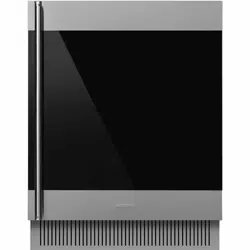Loading ...
Loading ...
Loading ...

USE - 1591477A923/A
e
characteristics in this type of wine.
Rosé wines
Serving rosé wines generally follows the same
rules as white wines. However, it is necessary to
consider the possible tannin content of these
wines and therefore serve them at a higher
temperature so as not to make them too
astringent. Young and fresh rosé wines, tannin
content permitting, are served between 50°F
(10°C) and 54°F (12°C), while the more
robust and full-bodied ones, including the more
mature ones, can be served between 54°F
(12°C) and 57°F (14°C).
Red wines
The serving temperature of red wines depends
on many factors, but given their "tannin content"
and less acidic nature than whites, they are
usually served at higher temperatures. Young
red wines with little tannin are usually served
between 57°F (14°C) and 61°F (16°C), while
full-bodied ones can be served as high as 61°F
(16°C), exceptionally even 64°F (18°C).
Young tannic and unstructured red wines can
also be served between 54°F (12°C) and
57°F (14°C) without being astringent and
remain appealing. This rule applies to "novello"
wines, which, due to their special winemaking
technique, are low in tannins and can be served
cooler than other red wines, while still being
enjoyable.
Sparkling wines
Given the large number of types of sparkling
wines that exist, establishing one rule that
applies to all would make little sense. Sweet
and aromatic white sparkling wines should be
served at a temperature of 46°F (8°C). In fact,
due to their aromaticity, they can withstand low
temperatures.
Sweet red sparkling wines such as Brachetto
can be served at temperatures between 50°F
(10°C) and 54°F (12°C). Again, the more
aromatic sparkling wines will tolerate lower
temperatures down to 46°F (8°C), while those
that are a bit more tannic will need to be raised
to as high as 57°F (14°C).
So-called "Charmat method" or "Martinotti
method" dry sparkling wines, such as some
Proseccos, can be served at temperatures
between 46°F (8°C) and 50°F (10°C).
A special consideration should be made for
"classic method" and "méthode Champenoise"
sparkling wines such as Champagne: generally
these sparkling wines are served at
temperatures between 8°C and 50°F (10°C),
however when it comes to important vintage
wines or at any rate sparkling wines aged for a
long time, one can go as high as 54°F (12°C)
so as to encourage the development of the
complex aromas that have slowly and
laboriously developed over time.
Raisin and fortified wines
The common characteristic of these two types of
wines is usually a high percentage of alcohol,
and both are often sweet. However, there are
some dry fortified wines, e.g., Marsala, that
contain so much sugar that it is not noticeable to
the taste. For these wines, the serving
temperature should be determined according to
what you intend to enhance. If you prefer to
accentuate the sweet characteristics of the wine,
the complexity of its aroma and its austerity, it
will be good to serve it at a high temperature,
between 57°F (14°C) and 64°F (18°C),
remembering in this case that it will also be the
alcohol that will be enhanced.
If you intend to favor their freshness, or in the
case of very sweet wines where you prefer to
mitigate this aspect, you will need to serve them
at a lower temperature between 50°F (10°C)
and 57°F (14°C).
Fresh, young dry fortified wines can also be
served at cooler temperatures below 50°F
(10°C). This will greatly reduce the perception
of alcohol. However, it is necessary to
remember that the lower the temperature, the
less the aromas will develop. The pleasantness
and complexity of aromas typical of these wines
is a welcome and interesting feature; serving
them too cold also means sacrificing this
important aspect.
Storage temperatures
To appreciate the organoleptic qualities of any
wine properly, storage and consumption must
be done at certain temperatures. The following
ideal temperatures are recommended for
different types of wine.
Type of wine
Temp.
(°F) (°C)
Young whites 50-54 10-12
Mature whites 54-57 12-14
Young and light rosés 50-54 10-12
Ripe, full-bodied rosés 54-57 12-14
Loading ...
Loading ...
Loading ...
